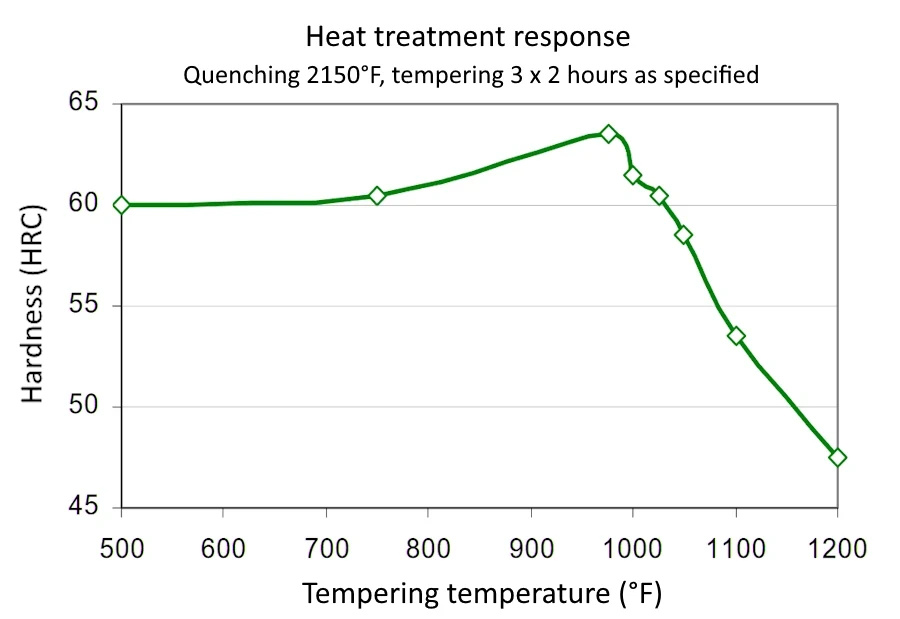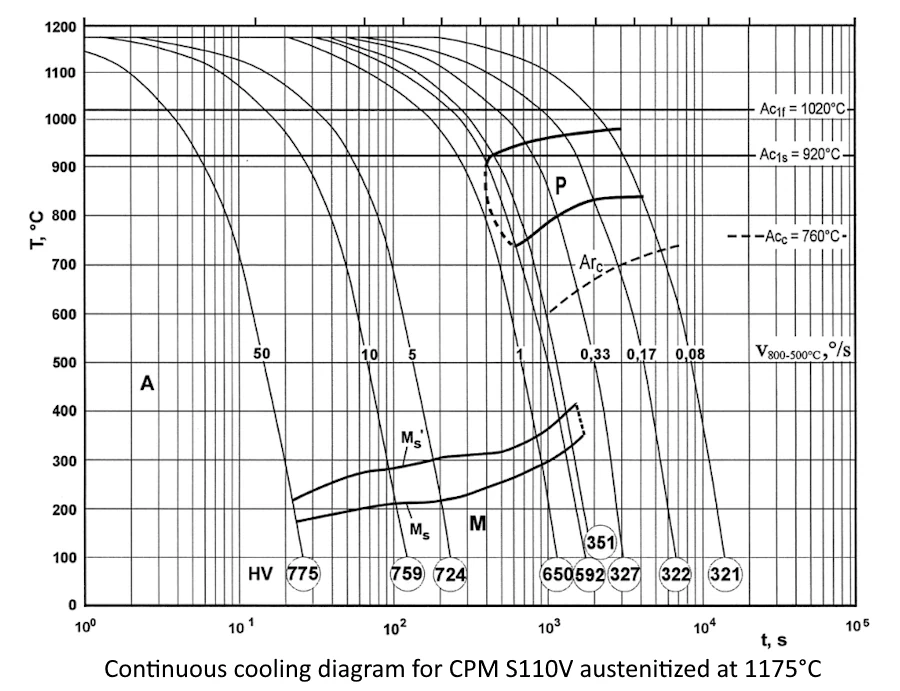CPM S110V is a high-alloy martensitic stainless tool steel manufactured by the crucible metallurgy process (CPM). CPM S110V (cpm-s110v) contains a high volume fraction of both vanadium-rich and niobium-rich primary alloy carbides for good wear resistance compared to other commercially available tool steels. It also provides better corrosion resistance than 440C or CPM S90V.
CPM S110V (cmp 110v) is only available by special request in HIP condition or as a poster layer on components. It is not available in forged or rolled bar lengths.
The CPM process ensures fine and uniform distribution of carbides in CPM S110V steel compared to conventionally produced high alloy tool steels, resulting in relatively good machining, grinding and toughness properties despite the high alloying element content.
The steel was first introduced in 2005 by Crucible Industries. The hardness is 60 - 64 HRC. CPM S110V steel has good wear resistance, and its corrosion resistance is perhaps even better than CPM S125V. The addition of niobium to the alloy has led to the formation of very hard and small carbides, which can lead to a decrease in edge aggressiveness. The steel belongs to the premium class.
Application
Solid or clad components manufactured by the HIP process requiring a combination of high wear resistance and good corrosion resistance, such as:
- Screw elements, cylinders and liners for compounding machines;
- Industrial knives, cutters and disc cutters;
- Rollers and wear-resistant components for food and chemical processing.
Mechanical processing and grinding
Due to its carbide content and high annealed hardness, CPM S110V will be more difficult to machine and grind than 440C (or D2) and comparable to or slightly more difficult than CPM S90V. Grinding equipment and methods similar to those used for CPM S90V are acceptable. For best performance with CPM, SG type aluminum oxide or CBN wheels are recommended.
Corrosion resistance
CPM S110V exhibits superior corrosion resistance compared to other high-hardness martensitic stainless tool steels such as 440C and CPM S90V.
Chemical composition
Chemical composition of steel grade CPM S110V | ||||||||
| C | Cr | Mo | V | Mn | Nb | Si | Co | Fe |
| 2,8 - 2,9 | 14,0 - 15,3 | 0,9 - 1,2 | 9,0 | 0,4 | 3,0 | 0,6 | 2,5 | Other |
Wear resistance
CPM S110V has the same high vanadium content as CPM S90V, plus an added contribution of 3.0% niobium, resulting in a 25% increase in wear-resistant carbides, including 50% more wear-resistant.
Thermal treatments
Annealing
Heat to 900 °C, hold for 2 hours, cool slowly at a maximum rate of 15 °C per hour to 595 °C, then cool in an oven or in air to room temperature.
Hardness after annealing: about 350-400 BHN.
Stress relieving
- Annealed material: heat to 595 - 705 °C, hold for 2 hours, cool in an oven or in air.
- Hardened material: heat to a temperature of 15 - 30 °C below the original tempering temperature, hold for 2 hours, then cool in an oven or in air.
Hardening
- Austenitize: 1175 °C. Duration 20 minutes.
- Quenching: salt quenching, intermittent oil quenching, gas quenching under positive pressure or air cooling at a minimum cooling rate of 140 °C/min to a temperature below 540 °C. Cool to below 50 °C before curing. Gas quenching at a minimum pressure of 4 bar is recommended for optimal reaction of vacuum heat treatment.
- Temper: temper three times, minimum holding time 2 hours at each tempering temperature. Cool completely to room temperature between temperings.
Tempering temperatures:
- 200 - 400 °C: better corrosion resistance;
- 525 - 540 °C: maximum hardness and compressive yield strength, reduced corrosion resistance;
- 550 - 565 °C: optimal for better stress relief and dimensional stability.Note: Tempering any martensitic stainless steel above 400°C may reduce its corrosion resistance.

Table: Heat treatment response of CPM S110V steel °F 500 750 975 1000 1025 1050 1100 1200 °C 260 400 524 540 552 566 593 649 HRC 60 60,5 63,5 61,5 60,5 58,5 53,5 47,5 - Deep freeze (optional): during tempering at 400 °C (750 °F) or below, a freeze treatment may be used between the first and second tempering to reduce retained austenite and maximize hardness. Freeze treatment should always be followed by at least one quench.
- Size change: +0.03 to +0.05% for fully martensitic microstructure. Presence of residual austenite may reduce net growth.
Typical application hardness: 58/61 HRC.

Note: The properties given on this data page are typical values. Normal variations in chemical composition, size and heat treatment conditions may cause deviations from these values.
